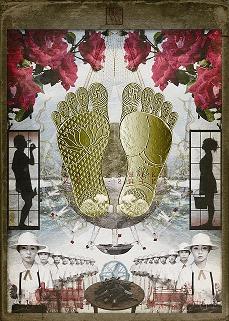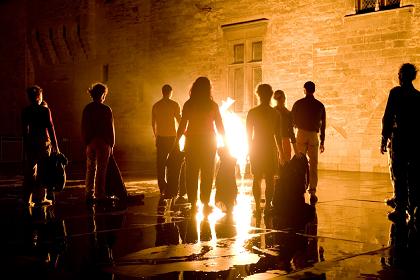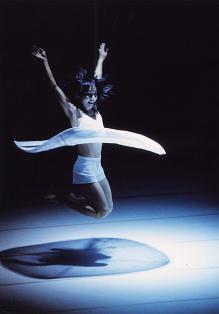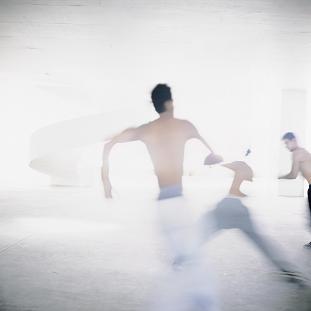I know what it's like. You love theatre and you want to see something. But you don't speak Japanese and you don't want to sit through a two-hour piece where you can't understand what's going on.
In this blog report we'll give you the lowdown on which productions are best to see if you don't speak Japanese.
Ishinha's "Rojishiki" will be the opening work of the Festival and their first Tokyo performance in eight years. Though the company is famous for its Balinese rhythmic chanting and dialogue in the Osaka dialect, in fact Ishinha's work occupies a unique halfway point between dance and theatre. Dialogue and dialogue-driven narrative is relegated to a secondary position in place of the sheer visual power of its giant set pieces. With the performers donning white make-up, Ishinha clearly play with circus motifs and mime is a central technique in their productions. Not being able to understand the few words that appear should not detract from an appreciation of the theatricality and the themes being explored.

"La Divina Commedia" is a vast and visual work, a trilogy based on Dante's poem that will feature a huge cast. Possibly one of the most ambitious productions ever undertaken in Tokyo, this mammoth event is truly universal in its themes and style. Its director is Italian Romeo Castellucci, who showed us with "Hey Girl!" at the spring Festival that his productions are almost silent spectacles.

© Luca del Pia
Real-time economics experiment "Dead Cat Bounce" was originally created in English and German. Though director Chris Kondek will be adapting the work for Tokyo audiences a lot of the play will still be in English. "Dead Cat Bounce" is hard to define: it is not so much a play as a piece of reality theatre. Kondek and his cast will use the box office takings to gamble on the London stock exchange. The performance will measure the ups and downs of the cash - and hopefully they will make a profit for everyone!
![Dead_Cat_Bounce[1].jpg](http://festival-tokyo.jp/09at/en/special/Dead_Cat_Bounce%5B1%5D.jpg)
© Can Mileva Rastovic
BATIK will be reviving their breakthrough work "Flowers flow, time congeals" . It is a strong and expressive dance piece, and an excellent introduction to choreographer Ikuyo Kuroda's intense style. The climax features the dancers leaping repeatedly down from high platforms onto the stage. This revival will also be re-imagined and re-made, giving it a freshness for the 2009 audience.

© Youichi Tsukada
Ankoku Butoh landmark performance "Unetsu - The Egg Stands out of Curiosity" is not to be missed for anyone interested in Japanese dance. Butoh is famous for its highly expressive, grotesque aesthetic, almost always performed without dialogue. This production is arguably the most famous contemporary Butoh performance ever and this rare Tokyo revival is a golden opportunity to experience a major company's definitive work.
"H3" is a Brazilian hip hop dance piece that surely will present no language barrier. From all accounts "H3" will be one of the fastest and most dynamic performances happening in the city this autumn, and will surely impress audiences with its bravado pace.

© Bruno Beltrão
Usually it is straight plays that present the biggest language barrier to foreign audiences, meaning you may be denied the chance to experience the latest developments in drama. Fortunately, Shu Matsui's Sample troupe will be presenting some of the performances of their new work with English surtitles. Matsui is an award-winning playwright and he directed the popular "Fireface" by Marius von Mayenburg at the spring Festival. "That Man's World" will be surtitled on November 14's two performances and the matinee of November 15.

"Burning up Calories" © Tsukasa Aoki
A leader of Tokyo fringe theatre, Gotandadan has gained popularity for their realistic portraits of youth. They will be presenting a duo of new plays at the Metropolitan Art Space as satellite shows linked to the main Festival, and one of these ("No One Alive Here?") will be also surtitled in English (October 26, 19:30; October 28, 15:00; October 29, 19:30), giving as wide an audience as possible a chance to appreciate the latest drama.
One of the many extra events surrounding the main Festival schedule will be at the F/T Station, the white bubble tent erected outside the Metropolitan Art Space in Ikebukuro. As with the spring Festival, the "Oyaji Café" will be taking up residence, serving patrons light refreshments and occasionally breaking out into bizarre dance routines. It has to be seen to be believed!

© Masahiro Hasunuma
Even for non-Japanese speakers there is still plenty of choice for shows to see.
English surtitled performances:
Sample: "That Man's World"
Nov 14: 14:00 & 19:30, Nov 15: 14:00
Gotanndadan: "No One Alive Here?"
Oct 26: 19:30, Oct 28: 15:00, Oct 29: 19:30
By William Andrews |








![Dead_Cat_Bounce[1].jpg](http://festival-tokyo.jp/09at/en/special/Dead_Cat_Bounce%5B1%5D.jpg)



